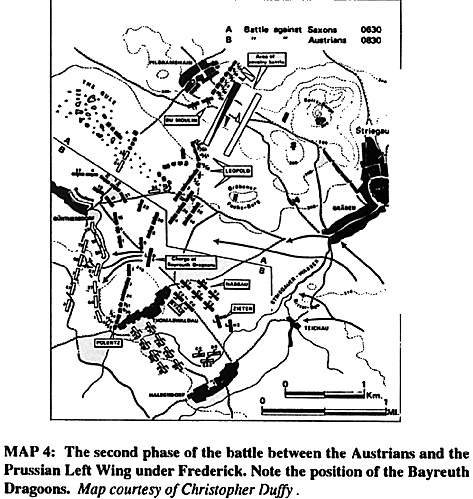Now that the Saxons and supporting Austrian cavalry on the Prussian right flank were disposed of, Frederick could turn his attention to the mass of Austrian infantry (33 battalions) that were deployed between Gunthersdorf and Thomaswaldau. The infantry and cavalry of the advance guard and right wing appear to have excused themselves from the rest of the battle. Presumably they were pursuing the Saxons beyond Eisdorf or securing new forward positions in The Gule.
From 7 A.M. to 8 A.M. elements of the Prussian left wing infantry crossed the Striegauer-wasser below Graben and marched in the direction of Gunthersdorf. Fourteen battalions advanced into The Gule, then wheeled left, placing them due north of Gunthersdorf. Next in line came the brigade of guard infantry commanded by Prince Ferdinand of Brunswick. La Motte's brigade (8 btns.) followed Ferdinand, but deployed in a second line behind the guards.
This left a wide gap in the center of the Prussian battle line, because the last three brigades (Polenz, Bredow and Munchow) veered left towards Thomaswaldau. Here was an excellent opportunity for an enterprising Austrian general to strike the forming Prussian line in the flank, but none was present on the field this day. Eventually, the huge ten squadron regiment of Bayreuth Dragoons deployed behind this gap and waited for their moment of fame.
Left Wing Cavalry Action
It seems that Kyau's ten squadrons of Prussian cuirassiers had no sooner crossed the Striegauer-wasser at Teichau, then the old plank bridge collapsed behind him. Kyau advanced across the open marshy ground between Thomaswaldau and Halbendorf completely unaware that the rest of the left wing cavalry was stranded on the other side of the stream.
The Austrian cavalry in this sector totaled 56 squadrons and were commanded by General Berlichingen, who assumed that the ground was too soft for cavalry to cross. He brought them to a halt opposite Kyau's brigade, south of Thomaswaldau. Kyau was to prove him wrong as the Prussians charged across the marsh -- 10 squadrons against 56. Kyau would have been overwhelmed but for the fact that General Zeiten had discovered a ford above Teichau and sent some dragoons and hussars aginst Berlichingen's second line before it could close in on Kyau. Soon thereafter, General Nassau brought the remaining Prussian cavalry across Zeiten's ford and improved the odds to 45 Prussian squadrons versus 66 Austrian squadrons.
While all this was happening, Polenz moved his brigade of Prussian grenadiers into Thomaswaldau and they proceeded to pepper the left flank of the Austrian cavalry with musket fire. Caught between these two dangers, the Austrian cavalry could not be persuaded to charge. Instead they fled. Berlichingen himself was captured during the rout.
The Final Phase In The Center
Now that the Austrian cavalry was out of play for the rest of the day, Frederick's infantry could advance on the Austrian infantry with impunity. A tremendous firefight erupted, with the Austrians getting the worst of it. The Austrians began to loose their cohesion and began to fall back.
I have observed, says Frederick, if you step sharply up to an Austrian battalion (50 paces) and pour in your fire well, in about a quarter hour, you see the ranks begin to shake and jumble towards indistinctness, a very hopeful symptom to you!" -- Thomas Carlyle
These words help explain what happened next. Recall how the Bayreuth Dragoon regiment deployed in the gap between Ferdinand's and Munchow's brigades in the Prussian center. Nobody knows who gave the actual order to charge; some attribute the order to Frederick's aide, Chasot, others give it to the brigade commander von Gessler and others credit the regimental colonel, Otto von Schwerin.
Whoever it was must have noticed the disordered state of the Austrian infantry formations to their front and figured that the shock blow from a cavalry charge could send them running. Since the conclusion of the First Silesian War, Prussian cavalry commanders had been trained to charge on their own initiative. The idea was to avoid a repeat of Mollwitz when the Austrian cavalry charged first and routed the Prussian cavalry.
Christopher Duffy estimates that the charge of the Bayreuth Dragoons commenced at 8:15 A.M. with an attack that swept aside some Austrian grenadiers, who were screening the front of their main battle line. The Bayreuths continued into the mass of Austrian infantry and within twenty minutes had put 20 battalions to flight, captured 67 colors, took 2500 prisoners and 5 guns. This famous charge demonstrated the most effective use of heavy battle cavalry, i.e. as a shock blow against weakened and disordered infantry.
The battle was over by 9 A.M. Charles ordered a retreat to Reichenau and the mountain passes. Nadasty's hussar reserve and Wallis' brigade of six infantry battalions provided a rear guard to cover the retreat. Estimates of allied losses vary from 13,000 to 16,000 killed, wounded and captured, with approximately 3,000 killed in action. Prussian casualties were approximately 4,700 including 900 killed. The allies retired into Bohemia to regroup. Frederick was slow to follow them and was content to camp in Northern Bohemia for the summer to eat up all the forage and supplies in that invasion staging area. The next encounter would not occur until Soor on September 30, 1745.
Map: Leopold's Attack
MAP 4: The second phase of the battle between the Austrians and the Prussian Left Wing under Frederick. Note the position of the Bayreuth Dragoons. Map courtesy of Christopher Duffy.

More Hohenfriedberg
- Hohenfriedberg: Introduction
Hohenfriedberg: March and Battle Openings
Hohenfriedberg: Prince Leopold Attacks
Hohenfriedberg: Second Battles vs. Austrians
Hohenfriedberg: Order of Battle
Back to Seven Years War Asso. Journal Vol. VI No. 2 Table of Contents
Back to Seven Years War Asso. Journal List of Issues
Back to Master Magazine List
© Copyright 1992 by James E. Purky
This article appears in MagWeb (Magazine Web) on the Internet World Wide Web.
Other military history articles and gaming articles are available at http://www.magweb.com